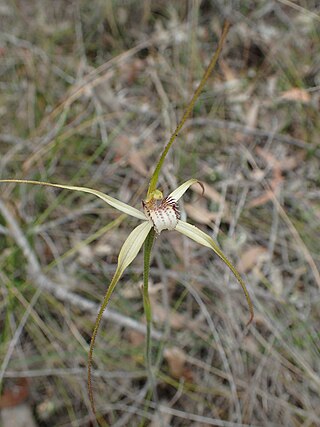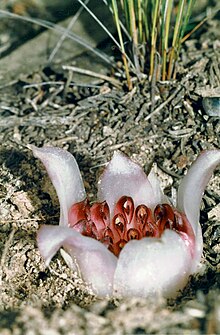
Rhizanthella gardneri, commonly known as western underground orchid, is a species of flowering plant in the orchid family and is endemic to the southwest of Western Australia. It is a herb that spends its entire life cycle, including flowering, at or below the soil surface. A head of up to 100 small reddish to cream-coloured, inward facing flowers surrounded by large, cream-coloured bracts with a horizontal rhizome is produced between May and July.

Rhizanthella, commonly known as underground orchids, is a genus of flowering plants in the orchid family, Orchidaceae and is endemic to Australia. All are leafless, living underground in symbiosis with mycorrhizal fungi. The inflorescence is a head of flowers held at, or just above the ground but mostly covered by soil or leaf litter and little is known about the mechanism of pollination.

Melaleuca uncinata, commonly known as broombush, broom honeymyrtle or brushwood, is a plant in the paperbark family native to southern Australia. It is harvested from the wild, and grown in plantations, for broombush fencing. The Noongar names for the plant are kwytyat and yilbarra.

Dr Maarten Joost Maria Christenhusz is a Dutch botanist, natural historian and photographer.

Melaleuca adenostyla is a plant in the myrtle family, Myrtaceae and is endemic to the south-west of Western Australia. It is a large, broom-like shrub to about 5 metres (16 ft) high with narrow leaves and cream-coloured flowers and which often grows in saline places.

Melaleuca protrusa is a shrub in the myrtle family, Myrtaceae, and is endemic to the south-west of Western Australia. It is a shrub with papery bark, narrow leaves with a hooked end and cream-coloured or yellow flowers. Although it was described as late as 2010, it is not considered a rare or endangered species. It resembles other members of the brushwood group such as M. uncinata, M. atroviridis and M. zeteticorum.
Caladenia bicalliata is a species of flowering plant in the orchid family Orchidaceae and is native to the south-west of Western Australia and coastal areas of South Australia. It has a single erect, hairy leaf and one or two cream-coloured flowers. There are two subspecies differing in the size and colour of the flowers.
Caladenia bryceana subsp. cracens, commonly known as the northern dwarf spider orchid, is a plant in the orchid family Orchidaceae and is endemic to the south-west of Western Australia. It has a single spreading, hairy leaf and a single green to apricot-coloured flower. It is a small orchid and difficult to find, even when quite abundant in a particular location. It has a more northerly distribution than subspecies bryceana which grows closer to Albany.

Caladenia christineae, commonly known as Christine's spider orchid, is a plant in the orchid family Orchidaceae and is endemic to the south-west of Western Australia. It has a single erect, hairy leaf and up to four small, white to cream-coloured flowers. It is distinguished from similar spider orchids by its small, odourless flowers with their stiffly held sepals and petals.
Caladenia denticulata subsp. rubella, commonly known as the clumped spider orchid, is a plant in the orchid family Orchidaceae and is endemic to the south-west of Western Australia. It has a single erect, hairy leaf and one or two dull or pinkish red flowers with prominent dull red markings and with a white labellum with red markings.

Caladenia dundasiae, commonly known as the Patricia's spider orchid and Dundas spider orchid is a species of orchid endemic to a small area in the south-west of Western Australia. It is a rare orchid with a single hairy leaf and one or two, usually red flowers with thin, stiffly-held lateral sepals and petals.

Caladenia gardneri, commonly known as the cherry spider orchid, is a species of orchid endemic to the south-west of Western Australia. It has a single, hairy leaf and up to three pale pink, sweetly scented flowers with a dark pinkish-red labellum.

Caladenia wanosa, commonly known as the Kalbarri spider orchid, is a species of orchid endemic to the south-west of Western Australia. It has a single erect, hairy leaf and one or two cream-coloured flowers with red stripes. It is common but only in a restricted area of the state.
Prasophyllum giganteum, commonly known as the bronze leek orchid, is a species of orchid endemic to the south-west of Western Australia. It is a tall, fragrant leek orchid with a single smooth, tubular leaf and up to fifty or more green and pinkish-purple flowers with a frilly labellum.
Caladenia lateritica, also known as white primrose orchid, is a plant in the orchid family Orchidaceae and is endemic to relatively inaccessible, high lateritic plateaux in a high rainfall area in south-western Western Australia. It is a ground orchid with a single hairy leaf and one or two white flowers on a thin, sparsely-hairy stem. It is similar to Caladenia flava but is distinguished by its fragrant white versus yellow flowers with prominent red stripes and spots on the dorsal sepal and lateral petals. Caladenia lateritica mimics Conostylis setosa (Haemodoraceae) in terms of flowering time, height, colour and fragrance. It also shares a native bee pollinator with Conostylis setosa, which provides pollen and nectar whereas the orchid is rewardless.
Caladenia rosea is a plant in the orchid family Orchidaceae and is endemic to relatively inaccessible, high lateritic plateaux in a high rainfall area in south-western Western Australia. It is a terrestrial orchid with a single hairy leaf and up to three pink flowers on a thin, sparsely-hairy stem. It is similar to Caladenia flava but is distinguished by the perianth being pink to dark pink with prominent red striping and spotting on the dorsal sepal and lateral petals. Caladenia rosea mimics Hypocalymma robustum (Myrtaceae) in terms of flowering time, colour and scent.
Rhizanthella speciosa is a species of flowering plant in the orchid family and is endemic to Barrington Tops in New South Wales. It is a mycoheterotrophic herb that spends its entire life cycle, including flowering, at or below the soil surface. As at September 2020, R. speciosa has not yet been accepted as a valid name by the World Checklist of Selected Plant Families or the Australian Plant Census.

Daviesia uncinata is a species of flowering plant in the family Fabaceae and is endemic to the south-west of Western Australia. It is a densely-branched shrub with many stems, hooked, needle-shaped, sharply pointed phyllodes continuous with the branchlets and rich yellow and pinkish-red flowers.

Caladenia exilis is a species of flowering plant in the orchid family Orchidaceae and is endemic to the south-west of Western Australia. It is a ground orchid with a single erect, linear leaf and up to three white to greenish-cream or dark pinkish-maroon flowers.

Caladenia pendens is a species of flowering plant in the orchid family and is endemic to the south-west of Western Australia. It has a single erect, linear leaf and up to three cream-coloured to dark pinkish-maroon flowers with reddish-purple markings.













